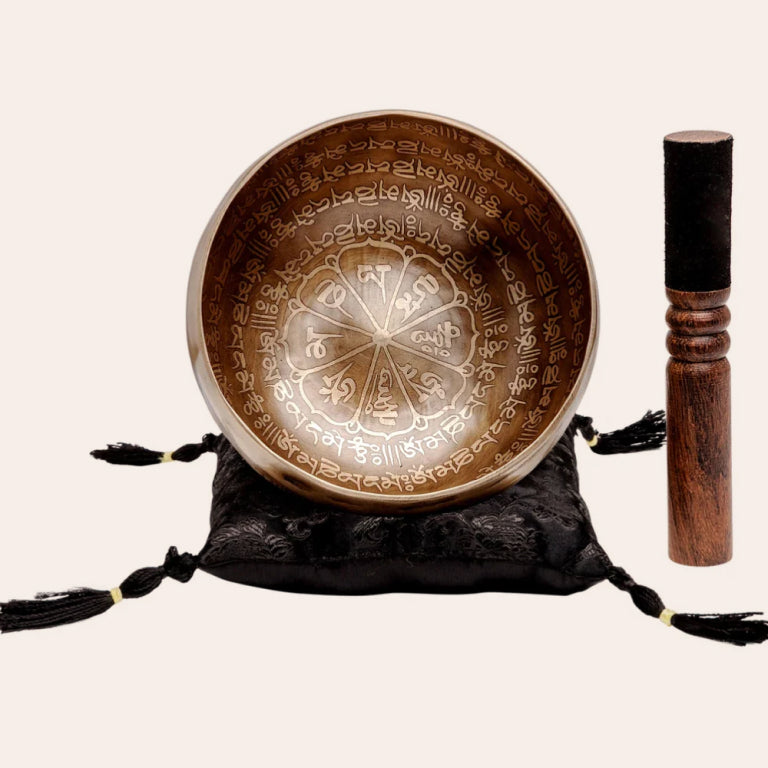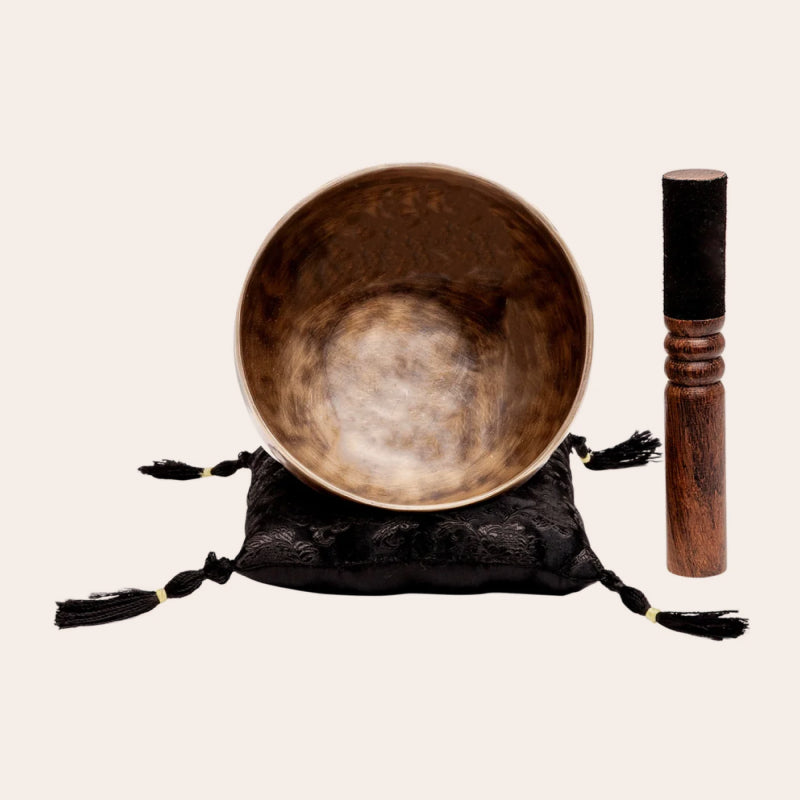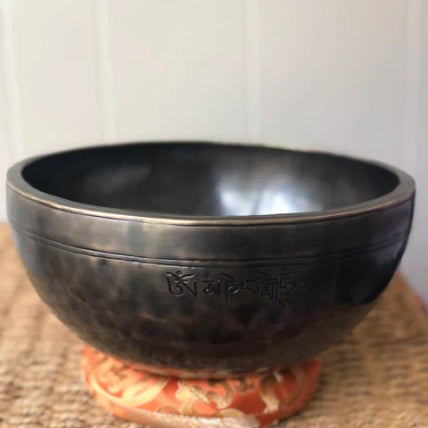Creating a transformative sound bath is something that can be learned by anyone, who holds sacred the intention of caring facilitation of others deeper into their own inner worlds.
You can begin with planning, an understanding of sound dynamics, and a compassionate approach to guiding participants through a journey of sensory exploration and personal introspection.
Importantly, facilitating sound meditation is a two-way street; participants must be actively engaged, prepared to delve deeply into their own sensory experiences to help heal themselves.
This guide provides step-by-step instructions for facilitating an unforgettable 90-minute sound bath for a small group, using handmade Tibetan singing bowls.
We'll cover everything from setting intentions to post-session integration, ensuring a profound and healing experience for everyone lucky enough to participate with you!
You can also watch the video below, if you prefer to consume this information that way!
Understanding the Fundamentals of Sound Healing
Sound healing is an ancient practice, used by many old cultures with many different instruments and vocal additions, that leverages the power of sound waves to restore balance and harmony to the human body.
The vibrations produced by instruments such as singing bowls resonate with the body’s molecules, promoting healing from within. According to a 2016 study published in the Journal of Evidence-Based Integrative Medicine, sound therapy can significantly reduce stress and anxiety, thereby enhancing overall well-being.
The Science Behind Singing Bowls
Singing bowls, traditionally made from an amalgam of metals, produce rich overtones and undertones when played. The frequencies emitted by these bowls can correspond to specific chakras or energy centers in the body, facilitating alignment and energetic flow.
Modern research suggests that the sounds and vibrations of singing bowls can stimulate immune function, reduce blood pressure, and improve circulation, thus catalyzing physical healing processes.
Step 1: Preparing the Space
Setting the Environment:
- Choose a quiet, comfortable room where interruptions will be minimized.
- Arrange comfortable seating or lying arrangements for each participant, ensuring adequate space for both privacy and comfort.
- Opt for dim lighting or candlelight to create a calming atmosphere.
- Consider aromatic elements like incense or essential oils to enhance the sensory experience, selecting scents known for their calming properties, such as lavender or sandalwood.
Acoustic Setup:
- Position your singing bowls around the room strategically. They should be easily reachable but also spread out enough to envelop the participants in sound.
- Test the acoustics beforehand by playing each bowl and observing how the sound travels in the space.
Step 2: Selecting Your Handmade Tibetan Singing Bowls
When choosing Tibetan singing bowls for your sound bath, it's important to focus on the quality, size, material, and tonal attributes of each bowl. Handmade Tibetan singing bowls are renowned for their rich harmonic overtones and sustained resonance, making them ideal for sound baths. Here’s a detailed guide to help you select the right bowls:
Understanding Handmade Tibetan Singing Bowls:
- Material Composition: Traditional Tibetan singing bowls are made from an alloy of various metals, commonly known as "bell metal," which typically includes a combination of copper and tin, and often incorporates traces of gold, silver, iron, lead, and mercury. Each metal contributes to the bowl’s unique sound.
- Craftsmanship: Handmade bowls are crafted using traditional hammering techniques. Each strike by the artisan shapes not only the bowl but also influences its sound characteristics. The subtle differences in thickness, shape, and size affect the vibration and the quality of sound.
Choosing the Right Bowls:
- Size and Weight: The size of the bowl affects its pitch and volume. Larger bowls produce deeper, lower tones and are often used to target lower chakras such as the Root and Sacral. Smaller bowls, conversely, emit higher pitches suitable for stimulating the Throat and Crown chakras.
- Sound Quality: Each bowl should be tested for its sound quality. Look for a bowl that sings easily with a rich, prolonged resonance. A well-made Tibetan bowl will produce multiple harmonic overtones when struck or rimmed. The sound should be pleasing and free from any jarring noise.
- Vibrational Frequency: The vibrational frequency of a bowl is crucial in how it interacts with the body. You can use a frequency tuner or a mobile app to help determine the fundamental frequency of each bowl, which can be matched to specific chakras:
- Root Chakra: Typically between 256–384 Hz
- Sacral Chakra: 288–432 Hz
- Solar Plexus Chakra: 320–480 Hz
- Heart Chakra: 341–512 Hz
- Throat Chakra: 384–576 Hz
- Third Eye Chakra: 426–640 Hz
- Crown Chakra: 480–720 Hz
Set Composition:
- Harmonic Relationships: Select bowls that not only sound good individually but also harmonize well with each other. Playing two or three bowls together should produce a pleasant set of overtones without dissonance.
- Range of Notes: To facilitate a full spectrum sound bath that can engage all chakras, include a range of bowls that cover low, mid, and high tones. This variety allows for a more dynamic and engaging experience.
Testing and Selecting Bowls:
- Testing in Person: Whenever possible, purchase bowls in person to test and hear them yourself. Striking each bowl gently with a mallet should give you a clear indication of its sound profile and how it resonates.
- Trusted Sources: Ensure that you buy from reputable dealers or directly from artisans known for their quality craftsmanship. This guarantees the authenticity and effectiveness of your singing bowls.
By integrating these detailed considerations when selecting your handmade Tibetan singing bowls, you ensure that your sound bath will be a deeply resonant and healing experience. Each bowl's unique properties will contribute to creating an enveloping atmosphere that promotes wellness and relaxation.
Step 3: Planning and Facilitating Your Sound Bath Session
Creating a truly transformative sound bath session with Tibetan singing bowls involves meticulous planning and attentive facilitation. Here's a detailed guide to structuring your session and responding to the needs of participants in real-time.
Session Outline:
- Introduction (10 minutes):
- Setting Expectations: Welcome participants warmly as they arrive. Once everyone is settled, briefly explain the purpose and process of the sound bath. For instance, you might say, "Thank you for joining today’s sound bath session. Over the next 90 minutes, we’ll go on a journey using the sounds and vibrations of these ancient Tibetan singing bowls to promote relaxation, healing, and inner peace."
- Discussing Intentions: Encourage participants to set a personal intention for the session, whether it's seeking relaxation, healing, or insight. You can facilitate this by asking, "As we prepare to start, I invite each of you to think about what you wish to achieve from today's session, whether it's clarity, relaxation, or emotional release."
- Grounding (10 minutes):
- Grounding Exercise: Guide participants through a grounding exercise to enhance their receptivity to the sound bath. You might lead a guided visualization, asking them to imagine roots growing from the soles of their feet deep into the earth, anchoring them gently but firmly to the ground.
- Breathing Techniques: Introduce deep breathing to help participants relax further. Instruct them, "Let’s take deep, slow breaths together. Inhale deeply, hold for a moment, and exhale slowly. Feel yourself relaxing more with each breath."
- Main Sound Bath (50 minutes):
- Beginning the Sound Bath: Start with the bowl tuned to the lowest frequency, generally associated with the Root Chakra. Strike the bowl gently and allow its vibrations to fill the room, setting the tone for a deeply immersive experience.
- Progressing Through the Bowls: Move sequentially from lower-pitched bowls to higher-pitched ones, aligning roughly with the progression of chakras from root to crown. Allow each bowl’s sound to overlap slightly with the next, creating a continuous flow of sound.
- Maintaining Flow and Responsiveness: Watch the reactions of your participants. If someone seems restless or uncomfortable, you might choose to soften the volume or shift to a different bowl more soothing for them. For instance, if a participant appears to become tense when higher frequencies are played, linger longer on the lower tones before transitioning upwards.
- Guiding the Experience: Periodically, use soft, soothing tones to guide participants' focus. For instance, during transitions, you might whisper, "Let the sound wash over you, carrying away tension," or "Focus on the sound as it moves from one ear to the other, surrounding you with warmth and comfort."
- Silence and Absorption (10 minutes):
- Introducing Silence: After the final bowl has been played, allow the room to settle into silence. This silence is profound, allowing participants to internalize their experience. You might say, "Let's embrace the quiet, and allow the resonance of the bowls to continue working within us."
- Observing Reactions: During this silence, observe. This is a crucial moment to gauge if the session is "working." Signs of relaxation include slow, steady breathing, relaxed facial expressions, and a general stillness or lack of fidgeting.
- Closing (10 minutes):
- Gently Reconvene: Slowly invite participants back into the shared space. You might suggest a gentle return to movement, such as wiggling fingers and toes.
- Sharing and Reflecting: Encourage participants to share their experiences. This helps validate their journey and deepens their understanding of the session's impact. Ask open-ended questions like, "What did you notice during the session?" or "How do you feel now compared to before we started?"
- Offering Thanks and Closure: Conclude by thanking everyone for their participation and offering some final thoughts, perhaps reminding them to drink water and take it easy for the rest of the day.
Adjustments and Real-Time Responses:
- Participant Discomfort: If a participant is visibly uncomfortable, consider lowering the volume or adjusting the pace. A gentle inquiry if they need assistance or a different approach can also be helpful.
- Signs of Emotional Release: If someone begins to cry or shows other signs of emotional release, maintain a supportive and non-intrusive presence. Adjust the sound to softer, slower rhythms to provide comfort.
By following these detailed steps and maintaining a responsive and caring approach, you can ensure that your sound bath session not only flows smoothly but also resonates deeply with all participants, fulfilling their individual intentions and promoting overall wellness.
Step 4: Mastering Resonance and Dissonance, Surrender, and Intuitive Play
To create the deepest and most immersive experience in a sound bath session using Tibetan singing bowls, it is crucial to understand and effectively utilize both resonance and dissonance. Additionally, playing intuitively while applying certain musical principles can significantly enhance the therapeutic impact. Here's a detailed guide to achieving this balance.
Understanding Resonance and Dissonance:
- Resonance:
- Definition and Role: Resonance in a sound bath refers to the harmonious alignment of tones that produces a pleasant, calming effect. This occurs when sound waves from the bowls complement each other, leading to a feeling of synchronization and balance.
- Techniques for Creating Resonance: To achieve resonance, select bowls whose fundamental tones and overtones harmonize. You can create sequences where the sound from one bowl naturally flows into the sound of the next, each one building upon the last to deepen the listener's state of meditation.
- Dissonance:
- Definition and Role: Dissonance involves a lack of harmony among musical notes but is not necessarily undesirable in a sound bath. When used carefully, dissonance can challenge the listener's expectations and enhance emotional release or bring attention to internal conflicts.
- Techniques for Using Dissonance: Introduce dissonance to briefly disrupt the harmonic flow, which can help facilitate breakthroughs in personal healing. For instance, playing two bowls that are slightly out of harmonic sync can create a tension, which when resolved by returning to harmonic sounds, can provide relief and a sense of resolution.
Surrender and Intuitive Play:
- Surrendering to the Moment:
- Letting Go of Control: To play the bowls effectively, release preconceived notions and expectations. Allow the session to unfold naturally, responding in real-time to the needs of the participants and the energy of the room.
- Being Present: Focus deeply on each sound you create and observe its impact on the participants. This mindful presence will guide your choices more effectively than any rigid plan.
- Playing Intuitively:
- Listening Deeply: Pay close attention to the sounds each bowl produces and how they interact. This will inform your decision on which bowl to play next based on what the moment requires.
- Responding to Feedback: Notice visible reactions from participants (e.g., changes in breathing, body movements). These cues can guide your playing, helping you decide when to introduce calming resonance or stimulating dissonance.
Musical Principles for Deep Experience:
- Dynamics:
- Volume Control: Use dynamics effectively by varying the volume from soft whispers to more robust sounds. This variation can help maintain interest and modulate the energy levels within the room.
- Crescendos and Decrescendos: Build up slowly to a peak sound level (crescendo) and then gradually reduce the volume (decrescendo). This can mimic the natural ebb and flow of emotions and energy within the human psyche, facilitating a deeper connection.
- Rhythm and Pace:
- Maintaining a Steady Rhythm: Even in a sound bath primarily focused on tone, the pace at which you switch between bowls can create a subtle rhythmic effect. A consistent, thoughtful pace can stabilize the mind, while unexpected changes can stimulate mental alertness.
- Pacing for Deep Meditation: Generally, slower transitions and longer-lasting tones help deepen meditation, promoting relaxation and introspection.
- Harmonic Sequencing:
- Creating Sequences: Plan sequences where the harmonic content of consecutive bowls builds on one another, either by climbing scale-wise or by skipping to harmonics that evoke particular emotions or energetic responses.
- Resolving Tensions: After any dissonant phase, resolve the tension musically by returning to a bowl whose sound is harmonically related to the preceding tension-creating tone.
By integrating these advanced techniques of resonance, dissonance, surrender, intuitive play, and musical principles, you can craft a sound bath session that is not only deeply therapeutic but also a profoundly moving experience for all participants. This approach allows you to navigate the session with flexibility and sensitivity, adapting dynamically to the unfolding needs of the group.
Step 5: Facilitating Integration During the Sound Bath
Integration is a pivotal aspect of the sound bath experience, where participants begin to assimilate the effects of the session into their conscious and subconscious mind. Here's how to effectively guide this process:
Facilitating Mindful Awareness:
- Guided Reflection:
- Prompt Reflection: Towards the end of the sound bath, invite participants to reflect on their experience. Guide them with questions such as, "What sensations did you notice during the session?" or "Were there moments of discomfort or profound peace?"
- Encourage Mindfulness: Suggest that participants observe without judgment, simply noting their experiences as they come. This helps develop an accepting and curious attitude towards their inner experiences.
- Journaling:
- Offer Notebooks: Provide participants with notebooks or encourage them to bring their own. After the session, allocate 5-10 minutes for them to jot down thoughts or doodle. This can be an invaluable tool for personal insights and tracking changes over multiple sessions.
- Share Prompts: Provide prompts that help direct their writing, such as "Describe the journey of sound through your body" or "What emotions did you feel during the session?"
Using Group Sharing:
- Circle Sharing:
- Facilitate a Sharing Circle: After journaling, form a circle and invite participants to share their insights with the group. This can be voluntary to ensure everyone feels comfortable.
- Listen Actively: As the facilitator, practice active listening. Validate participants' experiences by summarizing their stories or reflecting back key emotions they expressed. This acknowledgment can enhance their process of integration.
Incorporating Closing Rituals:
- Gratitude Practice:
- Lead a Gratitude Exercise: Have participants share one thing they felt grateful for during the session. This can shift their focus to positive aspects and frame their experience in a beneficial light.
- Express Gratitude: As a facilitator, express your gratitude towards the participants for sharing their energy and trust in the process.
Step 6: Post-Session Practices for Continued Integration
The integration process extends beyond the immediate aftermath of the sound bath. Encourage participants to continue this journey with practices and suggestions that can help them extend the benefits of the session into their daily lives.
Providing Resources:
- Handouts or Emails:
- Create Resource Lists: Offer a handout or a follow-up email with resources on sound healing, mindfulness techniques, and local meditation groups. This can help participants delve deeper into their own practices.
- Recommend Apps: Suggest meditation or mindfulness apps that offer guided sessions to help maintain the calm and centeredness they experienced.
Suggesting Daily Practices:
- Mindfulness Techniques:
- Encourage Daily Meditation: Recommend starting or ending the day with a short meditation, using an app or simply sitting in silence for a few minutes.
- Promote Mindful Listening: Suggest setting aside time to listen to soothing sounds or music with a focus on the quality of the sound and their bodily responses to these sounds.
- Physical Integration:
- Advocate Gentle Movement: Encourage practices like yoga or tai chi, which can help participants stay grounded and integrate the physical sensations experienced during the sound bath.
- Stress Physical Care: Remind them of the importance of hydration, rest, and nutrition as ways to nurture their bodies after the profound energetic work of a sound bath.
Encouraging Continued Reflection:
- Journal Continuation:
- Suggest Regular Entries: Recommend that they continue the journaling practice started during the session, noting daily feelings and experiences.
- Reflect on Changes: Urge participants to periodically review their entries to observe any long-term effects or shifts that may arise from the sound bath.
By providing detailed guidance on facilitating and encouraging integration both during and after the sound bath, facilitators can help ensure that participants derive the maximum benefit from their experience. These steps foster a deepened awareness and appreciation of the transformative power of sound baths, helping individuals to carry these benefits forward into their everyday lives.










